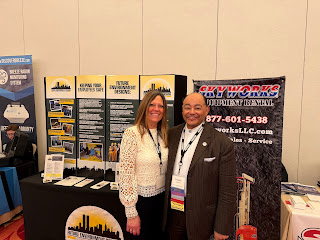- supplying personal protective equipment (PPE),
- providing quantitative respirator fit testing,
- providing respirator medical evaluations,
- our monthly Safety Suzy newsletter with content on asbestos, mold, indoor air quality, and occupational safety and health information,
- our blog where we post items of interest and discussion,
- our negative air app,
- our air sampling charts,
- our training library,
- our partnership with SiteDocs,
- and all of it found on FEDTC's website.
 |
| Anthony DiTucci in the Cayuga room, Ryan Carney (at the Podium), and Dr. David Duford in the Mohawk room |
After a small break in the Vendor Exhibition Hall, Dr. Joe Spurgeon, CIH, followed in the Mohawk room with a targeted presentation, “Write a Mold Assessment Report, Not a Data Report,” emphasizing the need for clear, actionable mold assessment reports. Spurgeon challenged attendees to move beyond merely collecting data and focus on producing comprehensive reports that drive decision-making. Zooming into the Cayuga Room, Dr. Barry Castleman delivered a hard-hitting presentation on the "Saranac Laboratory Coverups for the Asbestos Industry," revealing the historical injustices faced by asbestos victims and how industry efforts were made to downplay the dangers of asbestos exposure.
 |
| Joe Spurgeon in the Mohawk room and Barry Castleman zooming in the Cayuga room, |
Closing out the morning session in Mohawk room was Steven Smigielski and Sean Fitzgerald, of Encorus Group, who addressed another timely issue in their talk, "Impact of New York State's Building and Energy Code Revisions on Hazardous Material Abatement." They examined how these revisions are shaping hazardous materials management and abatement strategies, giving attendees practical insights into compliance and operational adjustments. Closing the morning session in the Cayuga Room, Megan Beaushemin, of New York State Department of Labor, provided a vital introduction to "NYS Code Rule 59 & 60," offering a comprehensive overview of these key regulations and how they impact worker safety practices and workers' compensation insurance.
 |
| Steven Smigielski and Sean Fitzgerald in the Mohawk room, and Megan Beauchemin in the Cayuga room |
After a networking lunch, the highlight of the day was undoubtedly the Asbestos Inspections Panel moderated by Angelo Garcia, III, of Future Environment Designs, Inc. This distinguished panel, titled "Asbestos Inspections: EPA, OSHA, NYSDOL, NYCDEP & ASTM. Different Requirements and Goals," brought together leading experts to explore the varying requirements and objectives in asbestos inspections. Tom Laubenthal, of TGL Consulting, Inc., led the discussion with a focus on the American Society of Testing and Materials (ASTM) E2356 standard, offering a technical perspective. Chris Alonge, of the Dormitory Authority of New York (DASNY), presented the building owner's perspective, diving into the importance of thorough inspections to protect occupants and workers. Mr. Alonge shared some of the resources DASNY (click here for the DASNY resource page) provides to environmental consultants and contractors working for DASNY. Marc Rutstein, of Environmental Consulting and Management Services, Inc., shared his insights as a consultant, highlighting the regulatory challenges in NYCDEP and NYSDOL compliance. Finally, Matthew Brooks, of International Asbestos Removal, Inc., wrapped up with a contractor’s view, emphasizing the real-world application and costs of when inspectors don't follow these standards on job sites. The panel then had a discussion regarding the Occupational Safety and Health Administration's (OSHA's) Varga Letter regarding materials containing one percent or less of asbestos and how those materials should be handled.
 |
| Front Row - Tom Laubenthal & Matthew Brooks Back Row - Chris Alonge, Marc Rutstein, & Angelo Garcia, III |
The afternoon continued with Peter DeLucia, of Riedman Companies, and Mark Wiktorski, of Wonder Windows Showers and Baths, tackling an important but often overlooked topic—mental health. Their presentation, “Breaking the Stigma: Mental Health as a Critical Component of Workplace Safety,” emphasized how breaking the stigma attached to mental health issues is important to maintaining a safe, productive work environment. An important website that promotes mental wellbeing in the workplace from the Construction Industry Alliance for Suicide Prevention.
 |
| Mark Wiktorski & Peter Delucia (at the Podium) |
Kevin Hutton, of EAST Centers of NY, rounded out the day with a much-anticipated session on "2024 TOP DOL Violations." His presentation gave attendees a close look at the year’s top safety violations, offering key takeaways for improving compliance and reducing risks in the workplace.
 |
| Kevin Hutton |
The day concluded with a lively happy hour in the exhibition hall, where a record 31 exhibitors were on hand, showcasing the latest products and services in the industry. It was a fitting end to a day full of rich learning and networking opportunities, giving attendees a chance to connect and unwind after a full day of presentations.
 |
| Always thankful for Sheryl Esposito's (and Matt Desch) presence managing the booth! |




























